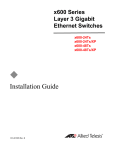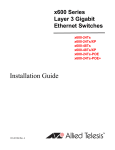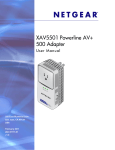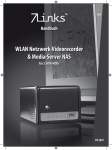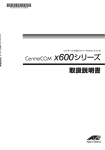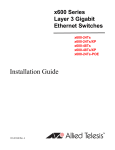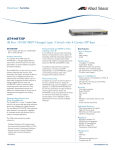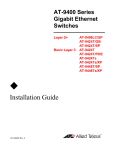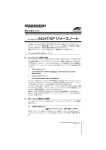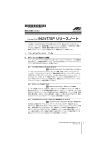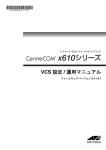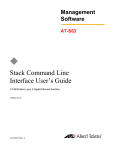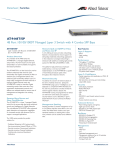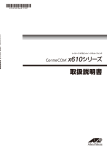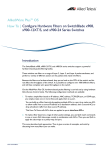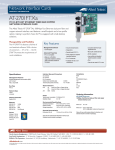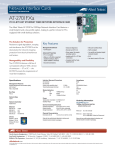Download Allied Telesis x600-48Ts/XP User's Manual
Transcript
x600 Series Layer 3 Gigabit Ethernet Switches x600-24Ts x600-24Ts/XP x600-48Ts x600-48Ts/XP ◆ Installation Guide 613-001065 Rev. A Copyright © 2008 Allied Telesis, Inc. All rights reserved. No part of this publication may be reproduced without prior written permission from Allied Telesis, Inc. Allied Telesis and the Allied Telesis logo are trademarks of Allied Telesis, Incorporated. All other product names, company names, logos or other designations mentioned herein are trademarks or registered trademarks of their respective owners. Allied Telesis, Inc. reserves the right to make changes in specifications and other information contained in this document without prior written notice. The information provided herein is subject to change without notice. In no event shall Allied Telesis, Inc. be liable for any incidental, special, indirect, or consequential damages whatsoever, including but not limited to lost profits, arising out of or related to this manual or the information contained herein, even if Allied Telesis, Inc. has been advised of, known, or should have known, the possibility of such damages. Electrical Safety and Emissions Standards This product meets the following standards. U.S. Federal Communications Commission Radiated Energy Note: This equipment has been tested and found to comply with the limits for a Class A digital device pursuant to Part 15 of FCC Rules. These limits are designed to provide reasonable protection against harmful interference when the equipment is operated in a commercial environment. This equipment generates, uses, and can radiate radio frequency energy and, if not installed and used in accordance with this instruction manual, may cause harmful interference to radio communications. Operation of this equipment in a residential area is likely to cause harmful interference in which case the user will be required to correct the interference at his own expense. Note: Modifications or changes not expressly approved of by the manufacturer or the FCC, can void your right to operate this equipment. Industry Canada This Class A digital apparatus complies with Canadian ICES-003. Cet appareil numérique de la classe A est conforme à la norme NMB-003 du Canada. RFI Emissions FCC Class A, EN55022 Class A, EN61000-3-2, EN61000-3-3, VCCI Class A, C-TICK, CE Warning: In a domestic environment this product may cause radio interference in which case the user may be required to take adequate measures. EMC (Immunity) EN55024 Electrical Safety EN60950-1 (TUV), EN60825-1 (TUV), UL 60950-1 (CULUS), CSA-C22-2 No. 60950-1 (CULUS) Laser Safety EN60825 3 Translated Safety Statements Important: The indicates that a translation of the safety statement is available in a document entitled Translated Safety Statements for the x600 Series Layer 3 Gigabit Ethernet Switches (613000990). 4 Contents Preface .............................................................................................................................................................. 7 Product Documentation ...................................................................................................................................... 8 Starting a Management Session ........................................................................................................................ 9 Safety Symbols Used in this Document ........................................................................................................... 10 Where to Find Web-based Guides ................................................................................................................... 11 Contacting Allied Telesis .................................................................................................................................. 12 Online Support ........................................................................................................................................... 12 Email and Telephone Support.................................................................................................................... 12 Warranty..................................................................................................................................................... 12 Returning Products .................................................................................................................................... 12 Sales or Corporate Information .................................................................................................................. 12 Management Software Updates................................................................................................................. 12 Chapter 1: Overview ...................................................................................................................................... 13 Introduction....................................................................................................................................................... 14 Switch Descriptions .......................................................................................................................................... 15 x600-24Ts Switch....................................................................................................................................... 15 x600-24Ts/XP Switch................................................................................................................................. 16 x600-48Ts Switch....................................................................................................................................... 17 x600-48Ts/XP Switch................................................................................................................................. 18 10/100/1000Base-T Twisted Pair Ports............................................................................................................ 19 Connector Type.......................................................................................................................................... 19 Speed......................................................................................................................................................... 19 Duplex Mode .............................................................................................................................................. 19 Maximum Distance..................................................................................................................................... 19 Cable Type................................................................................................................................................. 20 Auto-MDI/MDI-X......................................................................................................................................... 20 Port Pinouts................................................................................................................................................ 20 SFP Transceiver Slots...................................................................................................................................... 21 XFP Transceiver Slots...................................................................................................................................... 22 Redundant Twisted Pair Ports.......................................................................................................................... 23 SD Card Slot..................................................................................................................................................... 24 Port LEDs ......................................................................................................................................................... 25 10/100/1000Base-T Twisted Pair Port LEDs ............................................................................................. 25 SFP LEDs .................................................................................................................................................. 26 XFP Transceiver Slot LEDs ....................................................................................................................... 26 System LEDs.................................................................................................................................................... 27 Stack LEDs....................................................................................................................................................... 28 Secure Digital LEDs ......................................................................................................................................... 29 Terminal Port .................................................................................................................................................... 30 AT-RPS3204 Redundant Power Supply........................................................................................................... 31 AT-LBM Module................................................................................................................................................ 32 AC Power Connector........................................................................................................................................ 33 Chapter 2: Installing the Hardware .............................................................................................................. 35 Reviewing Safety Precautions.......................................................................................................................... 36 5 Contents Unpacking a Switch .......................................................................................................................................... 38 Installing the Power Cord Retaining Clip .......................................................................................................... 39 Installing the Switches in an Equipment Rack .................................................................................................. 40 Resetting the Switch ......................................................................................................................................... 42 Chapter 3: Cabling the Network Ports ......................................................................................................... 43 Twisted Pair and Fiber Optic Cable Specifications ........................................................................................... 44 Twisted Pair Cable Specifications .............................................................................................................. 44 Optional Transceiver Cable Specifications................................................................................................. 45 Installing Optional Transceivers ........................................................................................................................ 46 Installing an SFP Transceiver..................................................................................................................... 46 Installing an XFP Transceiver..................................................................................................................... 49 Cabling the Twisted Pair and Fiber Optic Ports ................................................................................................ 51 Powering on a Switch ....................................................................................................................................... 52 Starting a Local Management Session....................................................................................................... 53 Warranty Registration ....................................................................................................................................... 54 Chapter 4: Troubleshooting .......................................................................................................................... 55 Power LED is Off .............................................................................................................................................. 56 Twisted Pair Port Link LED is Off...................................................................................................................... 57 SFP or XFP LED is Off ..................................................................................................................................... 58 Transceiver is Installed but the Status is “Not Present” .................................................................................... 59 System Fault LED is Blinking ............................................................................................................................ 60 System Fault LED is Steadily On ...................................................................................................................... 61 Cannot Establish a Local (Out-of-Band) Management Session........................................................................ 62 Switch Functions Intermittently ......................................................................................................................... 63 Appendix A: Technical Specifications ......................................................................................................... 65 Physical Specifications ..................................................................................................................................... 65 Environmental Specifications ............................................................................................................................ 65 Power Specifications......................................................................................................................................... 66 Certifications ..................................................................................................................................................... 66 RJ-45 Twisted Pair Port Pinouts ....................................................................................................................... 67 RJ-45 Style Serial Terminal Port Pinouts.......................................................................................................... 69 RPS 21-pin D-combo Port and Connector Pinouts ........................................................................................... 70 6 Preface This guide contains the installation instructions for the x600 Series Layer 3 Gigabit Ethernet Switches. This preface contains the following sections: “Product Documentation” on page 8 “Starting a Management Session” on page 9 “Safety Symbols Used in this Document” on page 10 “Where to Find Web-based Guides” on page 11 “Contacting Allied Telesis” on page 12 7 Preface Product Documentation For overview information about the software features of the AlliedWare PlusTM Operating System Software which runs on the x600 Series Switches, refer to: 8 AlliedWare PlusTM Operating System Software Reference Guide x600 Layer 3 Gigabit Ethernet Switch Installation Guide Starting a Management Session For instructions that describe how to start a local management session on an x600 switch, refer to the “Starting a Local Management Session” on page 53. For information that describes how to log onto the AlliedPlusTM Operating System Software, see the AlliedWare PlusTM Operating System Software Reference Guide. 9 Preface Safety Symbols Used in this Document This document uses the safety symbols defined in Table 1. Table 1. Safety Symbols Symbol 10 Meaning Description Caution Performing or omitting a specific action may result in equipment damage or loss of data. Warning Performing or omitting a specific action may result in electrical shock. x600 Layer 3 Gigabit Ethernet Switch Installation Guide Where to Find Web-based Guides The installation and user guides for all Allied Telesis products are available in portable document format (PDF) on our web site at www.alliedtelesis.com. You can view the documents online or download them onto a local workstation or server. 11 Preface Contacting Allied Telesis This section provides Allied Telesis contact information for technical support as well as sales and corporate information. Online Support You can request technical support online by accessing the Allied Telesis Knowledge Base: www.alliedtelesis.com/support/kb.aspx. You can use the Knowledge Base to submit questions to our technical support staff and review answers to previously asked questions. Email and Telephone Support For Technical Support via email or telephone, refer to the Support section of the Allied Telesis web site: www.alliedtelesis.com. Warranty The x600 Series Layer 3 Gigabit Ethernet Switches are covered under a Lifetime Warranty (Two Years Fan & Power Supply). For warranty information, go to the Allied Telesis web site at www.alliedtelesis.com. Returning Products Products for return or repair must first be assigned a return materials authorization (RMA) number. A product sent to Allied Telesis without an RMA number will be returned to the sender at the sender’s expense. For instructions on how to obtain an RMA number, go to the Support section on our web site at www.alliedtelesis.com. Sales or Corporate Information You can contact Allied Telesis for sales or corporate information through our web site at www.alliedtelesis.com. Management Software Updates New releases of the management software for our managed products are available from the following Internet sites: Allied Telesis web site: www.alliedtelesis.com Allied Telesis FTP server: ftp://ftp.alliedtelesis.com If the FTP server prompts you to log on, enter “anonymous” as the user name and your email address as the password. 12 Chapter 1 Overview This chapter contains the following sections: “Introduction” on page 14 “Switch Descriptions” on page 15 “10/100/1000Base-T Twisted Pair Ports” on page 19 “SFP Transceiver Slots” on page 21 “XFP Transceiver Slots” on page 22 “Redundant Twisted Pair Ports” on page 23 “SD Card Slot” on page 24 “Port LEDs” on page 25 “System LEDs” on page 27 “Stack LEDs” on page 28 “Terminal Port” on page 30 “Secure Digital LEDs” on page 29 “AT-RPS3204 Redundant Power Supply” on page 31 “AT-LBM Module” on page 32 “AC Power Connector” on page 33 Note Do not begin the installation procedures in this guide until you have read the AlliedWare PlusTM Operating System Software Release Notes that are included with the latest release of the AlliedWare PlusTM Operating System Software. 13 Chapter 1: Overview Introduction The x600 Series Switches are managed Gigabit Ethernet switches that acts as standalone units. There are four Basic Layer 3 switches in the series: x600-24Ts Switch x600-24Ts/XP Switch x600-48Ts Switch x600-48Ts/XP Switch The x600-24Ts and the x600-24Ts/XP switches both have 24 10/100/1000Base-T ports. The x600-48Ts and the x600-48Ts/XP switches both have 44 10/100/1000 Base-T ports. All four switches have four SFP transceiver slots, an Secure Digital (SD) card slot, a console port, and a redundant power supply connector. In addition, the x600-24Ts/XP and the x600-48Ts/XP switches have two XFP transceiver slots. On the back of all the switches there is an AC power connector, an RPS connector, and an expansion slot. You can connect the RPS connector to the AT-RPS3204 Redundant Power Supply. The x600 switches are shipped with a blank expansion slot with the exception of the The x60048Ts/XP switch which is shipped with an AT-LBM (Link Back Mode) Module installed in the expansion slot. The AlliedWare PlusTM Operating System Software runs on all the x600 switches. For more detailed information about the switches, including illustrations, see “Switch Descriptions” on page 15. 14 x600 Series Layer 3 Gigabit Ethernet Switches Installation Guide Switch Descriptions The following sections describe the x600-24Ts, x600-24Ts/XP, x600-48Ts, x600-48Ts/XP Series Layer 3 Gigabit Ethernet Switches. x600-24Ts Switch The x600-24Ts switch has the following hardware features: 24 10/100/1000Base-T ports Four Gigabit Ethernet small form-factor pluggable (SFP) transceiver slots An RJ-45 style serial terminal port for local (out-of-band) management One SD slot supporting 512KB and 1GB SD cards Status LEDs for the ports, transceiver slots, and system Redundant power supply connector Expansion slot for the AT-StackXG Stacking Module Figure 1 shows the front panel of the x600-24Ts switch. Figure 2 shows the back panel of the x600-24Ts switch. System Port, SFP, and SD LEDs Slot LEDs 10/100/1000Base-T Ports 1 3 5 7 9 11 13 15 17 19 21R x600-24Ts 23R Layer 3 Gigabit Ethernet Switch PORT ACTIVITY L/A CLASS 1 LASER PRODUCT D/C 1000 LINK / FDX ACT 10/100 LINK / HDX / COL ACT SD READY BUSY STACK 1 3 5 7 9 11 13 15 17 SFP FAULT 2 L/A 21 FAULT L/A D/C 22 MASTER 23 RPS 24 PWR L/A L/A PRES D/C 2 2 4 6 8 10 12 14 16 18 20 22R 24R 21 22 23 STATUS 19 21R 23R MSTR SFP 1 CONSOLE L/A 4 6 8 10 12 14 16 18 RESET 20 22R 24R 24 1329 SFP Transceiver Slots RJ-45 Style Serial Terminal Port Figure 1. x600-24Ts Switch— Front Panel 100-240VAC~ RPS INPUT 1310 RPS Connector Expansion Slot AC Power Connector Figure 2. x600-24Ts Switch— Back Panel 15 Chapter 1: Overview x600-24Ts/XP Switch The x600-24Ts/XP switch has the following hardware features: 24 10/100/1000Base-T ports Four Gigabit Ethernet small form-factor pluggable (SFP) transceiver slots Two 10 Gigabit Ethernet small form factor pluggable (XFP) transceiver slots An RJ-45 style serial terminal port for local (out-of-band) management One SD slot supporting 512KB and 1GB SD cards Status LEDs for the ports, transceiver slots, and system Redundant power supply connector Expansion slot for the AT-StackXG Stacking Module Figure 3 shows the front panel of the x600-24Ts/XP switch. Figure 4 shows the back panel of the x600-24Ts/XP switch. Port, SFP, and SD Slot LEDs 10/100/1000Base-T Ports 1 3 5 7 9 11 13 15 17 19 21R x600-24Ts/XP 23R System LEDs Layer 3 Gigabit Ethernet Switch PORT ACTIVITY L/A CLASS 1 LASER PRODUCT D/C 1000 LINK / FDX ACT 10/100 LINK / HDX / COL ACT SD BUSY STACK SFP XFP L/A 1 1 6 8 10 12 14 16 18 20 22R 24R 21 22 23 24 25 5 7 9 11 13 15 17 CONSOLE STATUS L/A 19 21R 23R MSTR L/A 21 FAULT L/A D/C 22 MASTER 23 RPS 24 PWR L/A L/A PRES D/C 2 4 3 SFP FAULT XFP 2 2 READY 4 6 8 10 12 14 16 18 RESET 20 22R 24R 26 1307 SFP Slots XFP Slots RJ-45 Style Serial Terminal Port Figure 3. x600-24Ts/XP Switch— Front Panel 100-240VAC~ RPS INPUT 1310 RPS Connector Expansion Slot AC Power Connector Figure 4. x600-24Ts/XP Switch— Back Panel 16 x600 Series Layer 3 Gigabit Ethernet Switches Installation Guide x600-48Ts Switch The x600-48Ts switch has the following hardware features: 44 10/100/1000Base-T ports Four Gigabit Ethernet small form-factor pluggable (SFP) transceiver slots An RJ-45 style serial terminal port for local (out-of-band) management One SD slot supporting 512KB and 1GB SD cards Status LEDs for the ports, transceiver slots, and system Redundant power supply connector Expansion slot for the AT-StackXG Stacking Module Figure 5 shows the front panel of the x600-48Ts switch. Figure 6 shows the back panel of the x600-48Ts switch. RJ-45 Style Serial Terminal Port 10/100/1000Base-T Ports and LEDs SD Card Slot L/A L/A 1 3 5 7 9 11 13 15 17 19 1000 LINK / 21 ACT 10/100 LINK / 23 D/C ACT D/C 25 27 HDX / FDX 29 x600-48Ts COL 31 33 35 37 39 41 43 45 SFP Layer 3 Gigabit Ethernet Switch 47 SD READY BUSY FAULT CONSOLE STACK CLASS 1 LASER PRODUCT MSTR 1 L/A 2 L/A PRES 2 4 6 8 10 12 14 16 18 20 22 24 26 28 30 32 34 36 38 40 42 44 46 L/A STATUS FAULT MASTER RPS PWR RESET 48 1330 SFP Slots System LEDs Figure 5. x600-48Ts —Front Panel 100-240VAC~ RPS INPUT 1310 RPS Connector Expansion Slot AC Power Connector Figure 6. x600-48Ts —Back Panel 17 Chapter 1: Overview x600-48Ts/XP Switch The x600-48Ts/XP switch has the following hardware features: 44 10/100/1000Base-T ports Four Gigabit Ethernet small form-factor pluggable (SFP) transceiver slots Two 10 Gigabit Ethernet small form factor pluggable (XFP) transceiver slots An RJ-45 style serial terminal port for local (out-of-band) management One SD slot supporting 512KB and 1GB SD cards Status LEDs for the ports, transceiver slots, and system Redundant power supply connector AT-LBM module installed in the back of the switch Figure 7 shows the front panels of the x600-48Ts/XP switch. Figure 8 shows the back panel of the x600-48Ts/XP switch. RJ-45 Style Serial Terminal Port SD Card Slot 10/100/1000Base-T Ports and LEDs L/A L/A 1 3 5 7 9 11 13 15 17 19 1000 LINK / 21 ACT 10/100 LINK / 23 D/C ACT D/C 25 27 HDX / FDX 29 x600-48Ts/XP COL 31 33 35 37 39 41 43 45 SFP Layer 3 Gigabit Ethernet Switch 47 SD READY BUSY FAULT CONSOLE CLASS 1 LASER PRODUCT LINK / XFP SFP Slots 2 4 6 8 10 12 14 16 18 20 22 24 26 28 30 32 34 L/A ACT STACK XFP MSTR 1 L/A 2 L/A PRES 36 38 40 42 44 46 L/A 48 49 STATUS FAULT MASTER RPS PWR RESET 50 1308 XFP Slots SFP Slots System LEDs Figure 7. x600-48Ts/XP Switch —Front Panel 100-240VAC~ RPS INPUT AT-LBM 1309 AC Power Connector RPS Connector AT-LBM Module Figure 8. x600-48Ts/XP Switch —Back Panel 18 x600 Series Layer 3 Gigabit Ethernet Switches Installation Guide 10/100/1000Base-T Twisted Pair Ports This section describes the twisted pair ports on the switches. Connector Type Speed The ports are 8-pin RJ-45 connectors that use four pins at 10 or 100 Mbps and all eight pins at 1000 Mbps. For the pin assignments, refer to “RJ-45 Twisted Pair Port Pinouts” on page 67. A port’s speed can be 10, 100, or 1000 Mbps. The speed can be set automatically through Auto-Negotiation, the default setting, or manually with the AlliedWare PlusTM Operating System Software. Note To operate at 1000 Mbps, a twisted pair port must be set to Auto Negotiation. The speed of a twisted pair port cannot be set manually to 1000 Mbps. Duplex Mode A twisted pair port can operate in either half- or full-duplex mode. (Fullduplex mode is the only mode available when a port is operating at 1000 Mbps.) The twisted pair ports are IEEE 802.3u-compliant and AutoNegotiate the duplex mode setting. You can disable Auto-Negotiation on one or all of the switch ports so that you can set the duplex mode manually through the AlliedWare PlusTM Operating System Software. Note In order for a switch port to successfully Auto-Negotiate its duplex mode with a 10 or 100 Mbps end node, the end node must be configured for Auto-Negotiation. Otherwise, a duplex mode mismatch can occur. A switch port using Auto-Negotiation defaults to half-duplex if it detects that the end node is not using AutoNegotiation. This results in a mismatch if the end node is operating at a fixed duplex mode of full-duplex. To avoid this problem when connecting an end node with a fixed duplex mode of full-duplex to a switch port, use the AlliedWare PlusTM Operating System Software to disable Auto-Negotiation on the port and set the port speed and duplex mode manually. Maximum Distance The ports have a maximum operating distance of 100 meters (328 feet). 19 Chapter 1: Overview Cable Type Auto-MDI/ MDI-X The cabling requirements for a 10/100/1000Base-T port are: For 10 Mbps operation: Standard TIA/EIA 568-B-compliant Category 3 or better shielded or unshielded cabling with 100 ohm impedance and a frequency of 16 MHz. For 100 Mbps operation: Standard TIA/EIA 568-A-compliant Category 5 or TIA/EIA 568-B-compliant Enhanced Category 5 (Cat 5e) shielded or unshielded cabling with 100 ohm impedance and a frequency of 100 MHz. For 1000 Mbps operation: Standard TIA/EIA 568-A-compliant Category 5 or TIA/EIA 568-B-compliant Enhanced Category 5 (Cat 5e) shielded or unshielded cabling with 100 ohm impedance and a frequency of 100 MHz. The twisted pair ports on the switch are IEEE 802ab-compliant and feature auto-MDI/MDI-X. This feature, available when a port’s speed and duplex mode are set through Auto-Negotiation, automatically configures a switch port to MDI or MDI-X depending on the wiring configuration of the port on the end node. This allows you to connect any network device to a port on the switch using a straight-through twisted pair cable. If Auto-Negotiation is disabled on a port and the speed and duplex mode are set manually, the auto-MDI/MDI-X feature is also disabled and the port’s wiring configuration defaults to the MDI-X setting. This setting can be configured with the AlliedWare PlusTM Operating System Software. Port Pinouts 20 Refer to Table 10 on page 67 for the port pinouts when a twisted pair port operates at 10 or 100 Mbps in the MDI configuration and Table 11 on page 67 for the MDI-X configuration. For port pinouts when a twisted pair port operates at 1000 Mbps, refer to Table 12 on page 68. x600 Series Layer 3 Gigabit Ethernet Switches Installation Guide SFP Transceiver Slots All of the x600 Series switches feature slots for four optional Gigabit Ethernet SFP transceivers that interconnect network devices over large distances using fiber optic cable. Figure 9 illustrates an SFP transceiver. Figure 9. SFP Transceiver Note For a list of supported SFP transceivers, contact your Allied Telesis sales representative. 21 Chapter 1: Overview XFP Transceiver Slots The x600-24Ts/XP and the x600-48Ts/XP Switches have two slots for optional XFP 10 Gigabit Ethernet transceivers to connect high speed, 10 gigabit devices to the switch or create high speed backbone networks between switches. Figure 10 shows an example of an XFP transceiver. 721 Figure 10. XFP Transceiver Note For a list of supported XFP transceivers, contact your Allied Telesis sales representative. 22 x600 Series Layer 3 Gigabit Ethernet Switches Installation Guide Redundant Twisted Pair Ports Four of the twisted pair ports on the x600-24-Ts and x600-24-Ts/XP switches are paired with SFP slots. The twisted pair ports are identified with the letter “R” for “Redundant” as part of their number on the faceplate of the unit. The ports and slots are listed in Table 2. Table 2. Twisted Pair Ports Matched with SFP Slots Models x600-24Ts and x600-24Ts/XP Ports and Slots 21R with SFP slot 21 22R with SFP slot 22 23R with SFP slot 23 24R with SFP slot 24 Follow these guidelines when using these ports and slots: Only one port in a pair can be active at a time. It can be either the twisted pair port or the corresponding SFP module. The twisted pair port is the active port when its SFP slot is empty, or when an SFP module is installed but has not established a link to an end node. The twisted pair port automatically changes to the redundant status mode when an SFP module establishes a link with an end node. A twisted pair port automatically transitions back to the active status when the link is lost on the SFP module. In nearly all cases, a twisted pair port and an SFP module share the same configuration settings, including port settings, VLAN assignments, access control lists, and Spanning Tree Protocol settings. An exception to the shared settings is port speed. If you disable AutoNegotiation on a twisted pair port and set the speed and duplex mode manually, the speed reverts to Auto-Negotiation when an SFP module establishes a link with an end node. 23 Chapter 1: Overview SD Card Slot All of the x600 Series Switches have an SD card slot which is designed for an SD card which stores configuration files and AlliedWare PlusTM Operating System Software image files. See Figure 11. x600-24Ts/X SD READY BUSY R FAULT 1 3 5 7 9 11 13 15 17 19 21R 23R 2 4 6 8 10 12 14 16 18 20 22R 24R L/A D/C L/A D/C 1318 Figure 11. SD Card Slot An SD card can








































































